#group tours uganda
Text
by Kylie Ora Lobell
Now, Klompas has come out with a book, “Stand-Up Nation: Israeli Resilience in the Wake of Disaster” (Wicked Son), which is a unique approach to Israel activism. Rather than sharing news about the war, this book highlights Israel’s altruism towards the world.
“Today, Israel is nicknamed the ‘Start-Up Nation,’ and it is celebrated for its booming economy and ingenious innovations,” she wrote in the book. “Less celebrated is the story of how Israel lifted up other nations as it lifted up itself — the story of Israel, a force for good in the world.”
“Today, Israel is nicknamed the ‘Start-Up Nation,’ and it is celebrated for its booming economy and ingenious innovations. Less celebrated is the story of how Israel lifted up other nations as it lifted up itself — the story of Israel, a force for good in the world.”

Klompas’ book outlines MASHAV’s work, such as when they built the first utility-scale solar field in East Africa, spearheaded clean water initiatives in Israel, Jordan, the West Bank and Gaza and provided meals to starving children in India.
“For a while, Israel became a global leader in supporting newly independent states. Precisely because it was small and poor, Israel had an advantage over larger, richer, and more established countries,” Klompas wrote. “It was a model and source of inspiration for newly emerging nations facing their own array of challenges.”
She saw this with her own eyes. After finishing up at the UN, she founded and led Project Inspire, an initiative to show Israel’s work in social, environmental and economic development in low-income nations. She ran tours in Uganda, Kenya, Guatemala, India and Nepal, showing participants how people in these countries utilize Israel’s teachings and technologies to tackle poverty and inequality.
When Klompas traveled, she saw Israel in “the most unlikely of places,” she wrote. “While trekking in East Africa and walking through a small craft market, I spotted a handmade beaded bracelet with the flag of Israel alongside bracelets with the flags of Kenya, Tanzania, and Uganda. In the remote hills of Nepal, I happened upon a group of children, and as I passed by they yelled to me: ‘Shalom! Namaste! Hello!’ In Uganda, I visited a remote island on Lake Victoria. Getting there required a windy bus ride, followed by a rickety boat ride, followed by another bumpy bus ride. When we finally reached Osanidde Village, an orphanage for children with HIV, we were greeted by teenagers who sang the Ugandan national anthem followed by ‘Hatikva.’”
“Stand-Up Nation” is a callback to what Israel really is, and what a massive impact the small Jewish State has had on the world – a much-needed reminder post-Oct. 7, when it is being bashed everywhere we look. Klompas believes that enough isn’t being done to communicate Israel’s nation-building initiatives.
“I think I’m the first one to write a book about it, if not one of the first,” she said. “I’m not sure that people who have been to Israel dozens of times are even familiar with MASHAV. How many people know this story about Israel as a developing country and founding an international development agency at the same time? It’s an untold story. And the more that I learn about it, the more it shocks me that people don’t know it.”
22 notes
·
View notes
Text
Nihiloxica - Source of Denial
Source of Denial is the second LP from Nihiloxica, the Bugandan techno outfit hailing from Kampala, Uganda. It comes after more than three long years since Kaloli, their acclaimed debut on Crammed Discs.
The album points a (middle) finger at the hostile immigration and freedom of movement policies implemented in the UK, as well as across the world. Fueled by their frustrations with this intentionally convoluted system, the group have produced their most cataclysmic effort to date.
The only spoken words we hear throughout the album, outside of studio outtake Preloya, are computer generated. They speak of application processes, character backgrounds, and accountability, blasted through crackled phone speakers. The effect is a Kafkaesque feedback loop: an avalanche of constant call tones, uncanny British accents and rigorous interrogative questioning. The frustrations are a problem the band, a defiantly global outfit, has faced continuously. A whole UK tour was cancelled in 2022, and recently, a UK show had to be performed with only three members due to problems with a certain conglomerate visa agency who “provide services” for the UK, as well as a growing number of countries.
“We wanted to create the sense of being in the endless, bureaucratic hell-hole of attempting to travel to a foreign country that deems itself superior to where you’re from. We’re focussing on the UK as that’s where we’ve had the most trouble, but the problem goes much, much further. In this system if you have a certain passport or have even visited a certain country then you’re an appropriate subject to be interrogated and insulted time and time again just to prove that you’re worthy to enter, and normally this involves proving you have a good enough reason to want to leave again! The arrogance of it is unbearable. This album was a way to express our disdain towards it... What exactly is the source of your denial? Your passport? Your bank balance? Your skin colour? You’ve paid huge sums of money to be thrown from one profit-driven “service centre” to another, each denying responsibility, each limiting your right to freedom of movement as a human being. Despite some other serious humanitarian shortcomings, Uganda accepts some of the highest numbers of refugees in the world. Meanwhile the UK is trying to send them away to Rwanda. That says it all.” - Nihiloxica
Nihiloxica is: Henry (Isa) Isabirye, Pete (pq) Jones, Henry (Prince) Kasoma, Jamiru (Jally) Mwanje and Jacob (Spooky-J) Maskell-Key.
Produced by Spooky-J and pq at Nyege Nyege HQ in Kampala.
Artwork by Vicky de Visser
17 notes
·
View notes
Text

The Batwa commonly known as pygmies are an endangered group of people inhabiting the Echuya forest reserve in Kisoro & Kabale. Believed to have migrated from Ituri forest of DR Congo, the Batwa are also a very important cultural attraction in Uganda.

A visit to the Batwa offers you opportunities to learn more about the history and way of life of these once-traditional food gatherers and hunters. You can add this fascinating tribe on your Uganda tour package for a full feel of culture, nature and wildlife. Being situated close to Bwindi forest- you could always venture here after your safari.
2 notes
·
View notes
Text
Summary of The Princess Royal's visit to Uganda (25-28 October 2022)

The Princess Royal, accompanied by Sir Tim Laurence, on a four-day visit to Uganda in support of a number of her Patronages.
Day One




The Princess Royal started the visit at the Medical Research Council (MRC), Uganda Virus Research Institute (UVRI) and London School of Hygiene and Tropical Medicine (LSHTM), Ugandan Research Unit.

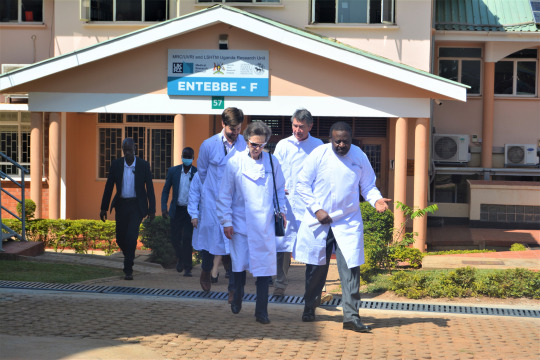

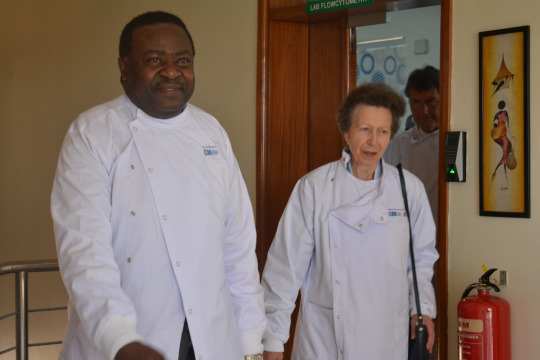


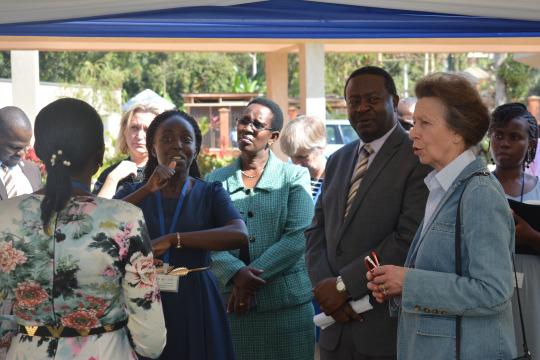
Her Royal Highness is Chancellor of LSHTM, and their Uganda unit is an internationally recognised centre of excellence.
During the visit, The Princess toured the facilities and learnt more about the unit’s work to conduct high quality, energy efficient research that is contributing to the development of strong health policies for the control of infectious and non-communicable diseases.


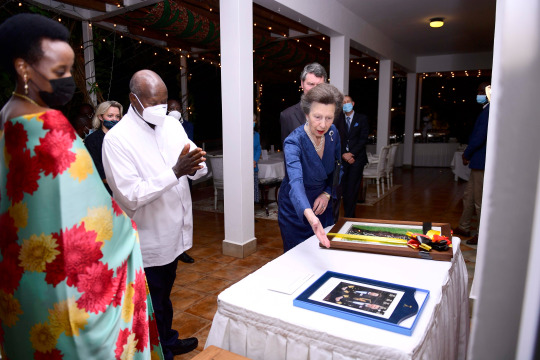

Her Royal Highness later had an Audience with the President of the Republic of Uganda, His Excellency Mr. Yoweri Museveni.
Day Two
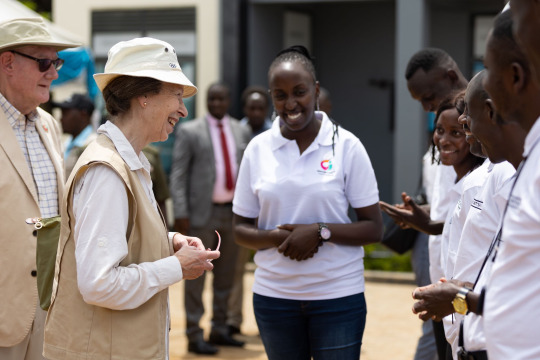

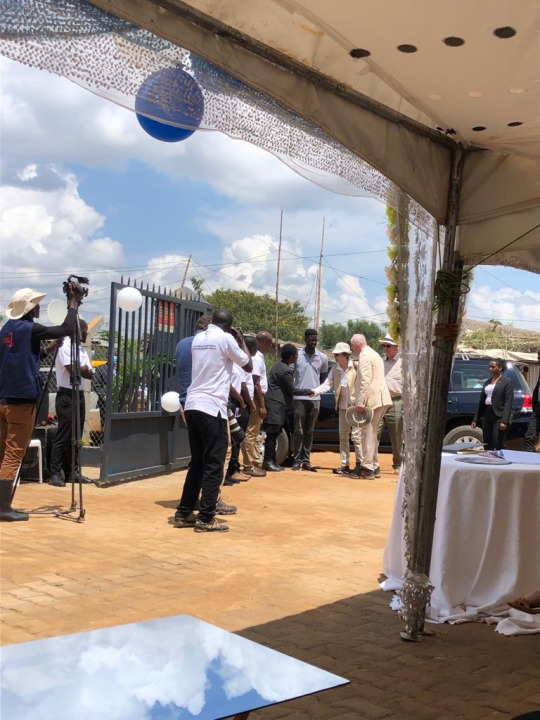
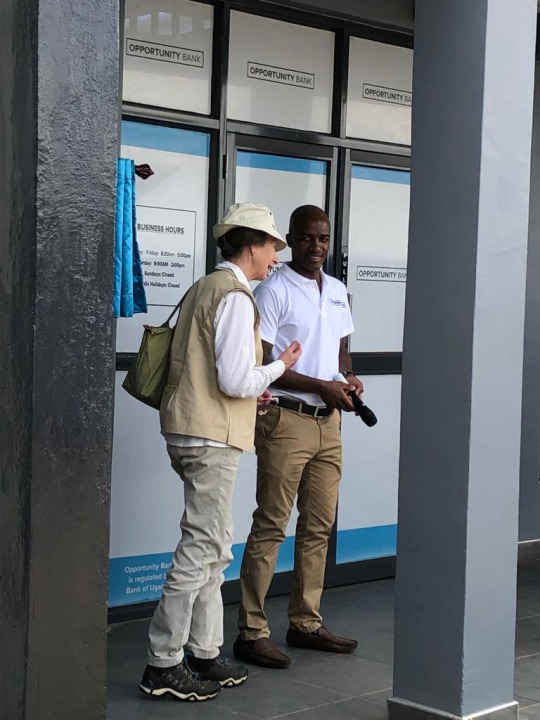
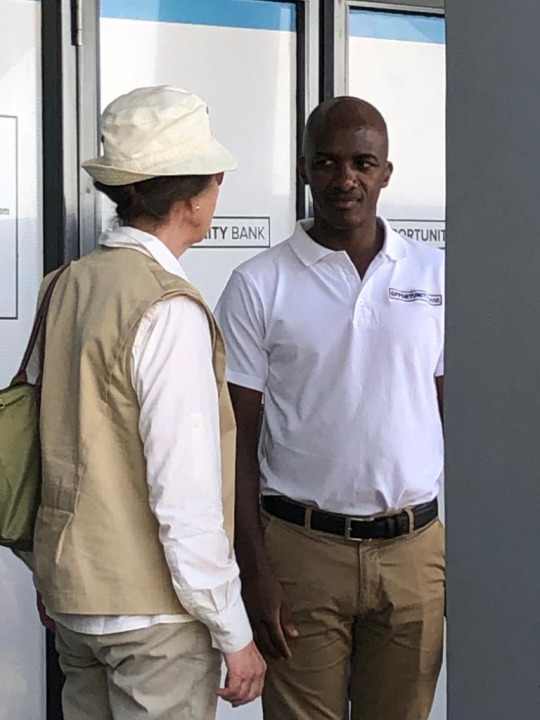
As Patron of Opportunity International UK, The Princess Royal opened Opportunity Bank Uganda Nakivale Branch at the Nakivale Refugee Settlement UNHCR Base Camp.
Opportunity International is a charity that works alongside local partners to ensure that people have the access to loans, training and saving to help to help work their way out of poverty.
Her Royal Highness unveiled a plaque to mark the opening of the charity’s first bank in a refugee settlement.
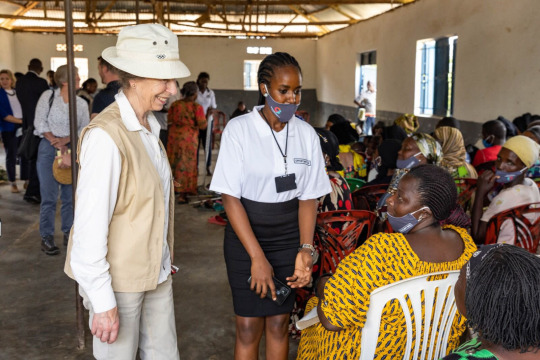
In Sangano, The Princess then met members of the Wenzetu Women's Group to discuss how Opportunity International has worked with the group to assist families of people with disabilities.
Her Royal Highness later visited Unleashed Youth Employment Project to meet refugee entrepreneurs who have benefitted from Opportunity Bank loans.
Day Three
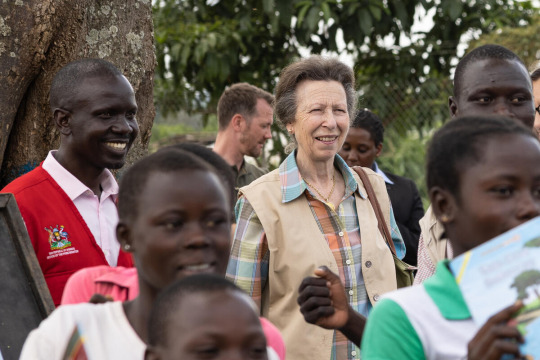


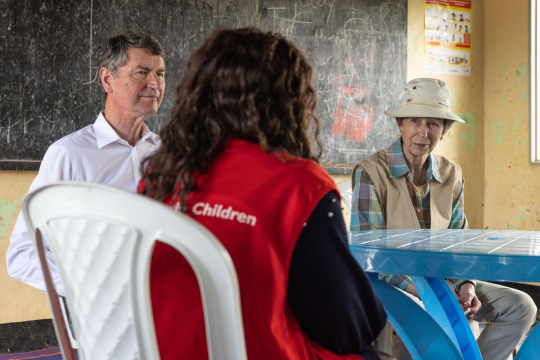
On the third day of Her Royal Highness’s visit, met families in Kyangwali Refugee Settlement in Uganda, to learn more about the impact conflict in the Democratic Republic of Congo (DRC) has had on children’s lives.
Uganda currently hosts 5 million refugees – the largest refugee population in Africa.
The Princess visited a school in Kyangwali Refugee Settlement where she joined a Save the Children Catch-up Club and took part in an activity with children to work together and build a story from pictures.
Later, Her Royal Highness also met children who have fled their homes due to the ongoing conflict in the DRC and are being supported by Save the Children’s child protection activities at a Child Friendly Space.
The Princess Royal became the Patron of Save the Children UK in 2017 after serving as the charity’s President since 1970.
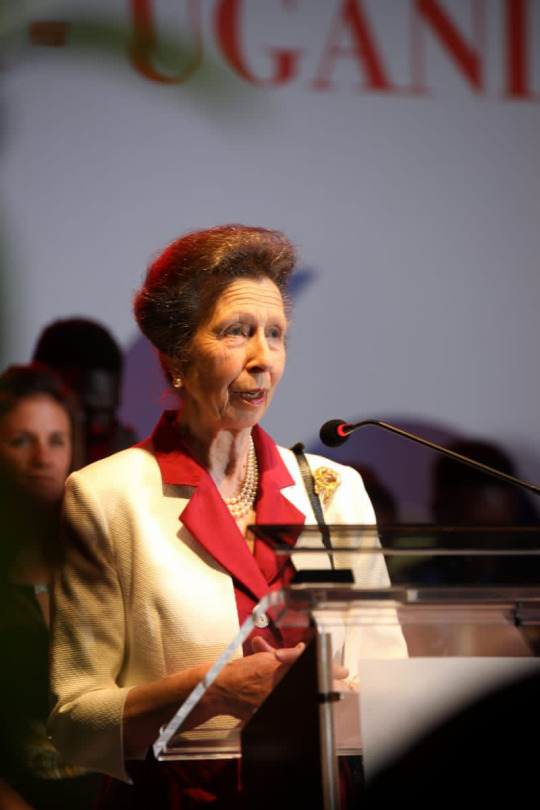

Day Four
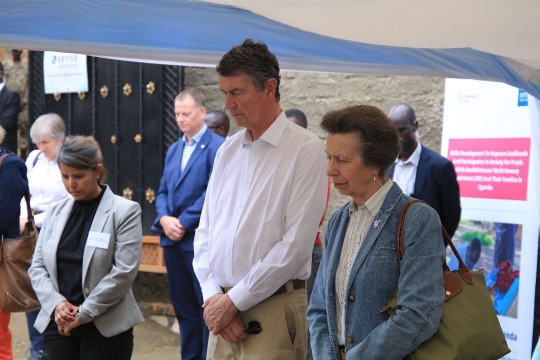
On Friday 28th October, The Princess Royal, as Patron, Sense International, accompanied by Vice Admiral Sir Tim Laurence, was due to visit the Salama School for the Blind in Mukono District, Uganda. As a result of the tragic fire at the school on Monday, Her Royal Highness visited the charity at its Head Office in Kampala, where Her Royal Highness met charity representatives and families it supports. The Princess Royal also had opportunity to pay her respects to those affected, by observing a minutes silence.
Her Royal Highness has shared the following message:
'I was shocked to hear the news of the tragic loss of life. The work of Sense International across many countries is hugely appreciated, working with such a vulnerable group of children. Our thoughts and prayers are with the families and staff.'
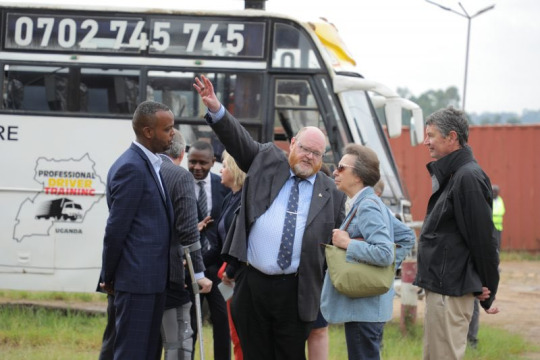
To finish her visit in Uganda, The Princess visited the ‘Safe Way Right Way Driver’ Training Centre to learn about Transaid projects in Uganda.
Her Royal Highness toured the driver training yard and met women trainee drivers taking part in the HGV training programme.
Safe Way Right Way’ was launched in 2013 in response to the huge rise in demand for HGV and PSV drivers.
Transaid’s road safety work focuses on influencing safe driver behaviour with long term programmes in Uganda, Tanzania, and Zambia.
Article by The Royal Family
56 notes
·
View notes
Text



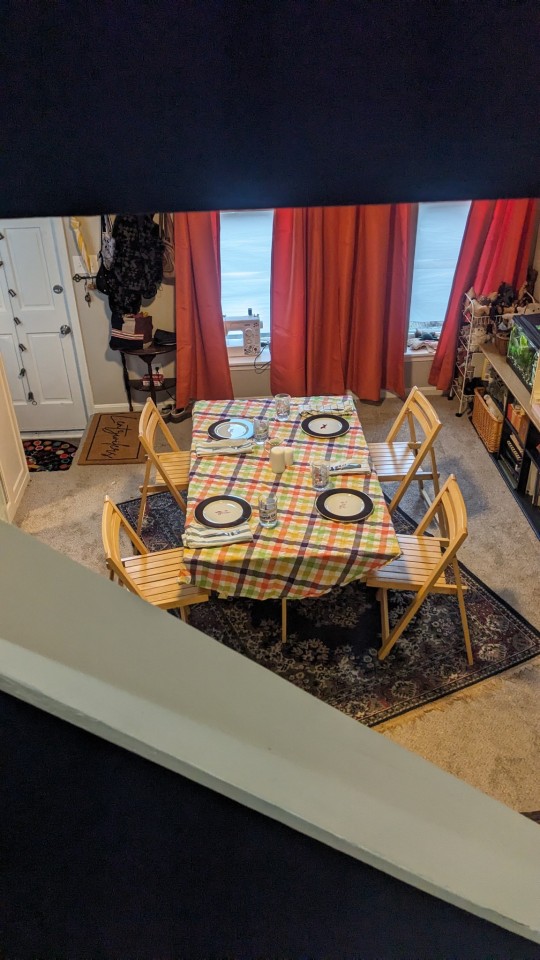

I am to full again! I ate to much yesterday and I ate to much this evening. It's fine. I will survive. But I am just super tired. It was another rainy rainy day but I had to go to work. It was a fully day.
I didn't sleep amazing. It wasn't horrible but it wasn't as restful as I would hope. I woke up a little after my alarm. James had gotten up late and was stressing. They would run out to put gas in the car and I appreciated that a lot. They were back by the time I was ready to go. We had a big hug and I was sent off into the rain. And the rain was bad. It was hard to see at times. It was not a comfortable drive in. But I think people stayed off the road a little because the rain was so heavy. It was not busy.
I got to camp and it was very rainy but still really pretty. I would settle myself in and spend some time just eating my breakfast and getting my knitting caught up. I finished my march square and I'm starting to sew down the edges. Which continue to vex me because of the terrible yarn decision I made. I will never use this fluffy nonsense again. Only plush.
I would get a lot of stuff done today. I was very very focused on getting my lessons done. And I wouldn't finish them all but I got so many of them filled out and that felt great.
I tried to take breaks so I wouldn't lose it. I would have liked a walk but it was just raining to much. So I would just poke around online. And started doing some research for art projects. And emailing people about feildtrips. Who I then absolutely confused because I had two schools with the same name but are not the same group. Oops. I got it sorted out!
We had a staff meeting later in the day. Which was interesting but not pertinent to me. I did stat an extra half hour but once there wasn't anything for me to share Heather said I could head out. Excellent.
It was a nice drive home, even with the rain. I saw another single car accident. You know they were going to fast. But it looked like no one was hurt. And I got home at 515.
I was really happy to see James. And they had a little gift for me! A pin designed by someone I follow on here. It is so pretty. Greer's illustrations are just so excellent.
James has cleaned up the house and we set up the table in the studio for dinner. I set the table while James finished up some cooking. They had made bread for croutons and garlic bread. They made ravioli. They made cinnamon rolls. Everything was going to be wonderful.
The Fulwilers would arrive around 645. And I was excited to share the house and the things we've done. And they were all excited for us and that felt so good.
We would give them a tour and then to the studio for dinner. And it was so good. James did a wonderful job and the food was great. And it was nice to talk about art and museums and things we've done for the house and things were doing to get ready for Uganda. It was a really nice way to spend the evening.
Sweetp was being real cute. And Tucker complimented my fish tanks. It was nice to share my animals. I know they are not great with cats but the Fulwilers did very good being nice to my baby.
They would head out around 8. A nice dinner. Hugs all around. And me and James worked on putting everything away.
Once we were settled, I went to take a bath. The water actually warmed up a little! That was exciting. James still filled a bucket for me and that was very hot and made my muscles not feel so tense.
Now I am in bed. And really tired and still to full. So I'm going to sip water and try to fall asleep before midnight.
Tomorrow we were supposed to have a feildtrips but the weather is going to be very bad. Gross. So they rescheduled. I don't know what that means for my day. But I hope it is a good day.
Sleep good everyone. I love you all. Goodnight!!
3 notes
·
View notes
Text
The end of the first week.
Friday 22nd September 23
I woke 6ish just as dawn was breaking. Today there seemed to be a competition between the muezzins and the Christians as to who could most effectively disturb the peace using their loudspeakers. I regret to say the Christians won – they went on a lot longer than the muezzins.

My birthday began with a ceremonial opening of cards and presents which Ewan had brought with him, all lovely, then at breakfast Sister Lydia led a great chorus of Happy birthday to you, with our students and a grand group of nuns who were staying overnight. What a splendid beginning.
We spent much of the day at Lubaga hospital, where they have taken up the challenge of developing mental health and are running with it enthusiastically. Their service is now officially on the list of services offered by the hospital, which has become a Regional Referral Hospital. Mental Health now has a Budget! And a mental health consultation room.

The consulting room and some of the enthusiastic staff.
You might think these are par for the course, and indeed they would be in the UK. But here such developments are also symbolic: the importance of the service is recognised, and resources are set aside for its continuance. Wow. That doesn’t happen often in a low income country like Uganda.
After the meeting, which included a report on the service and all kinds of responses, we had breakfast just before 12. This consisted of sausages, potatoes, plantains and spinach. Um…Yum??!

One of the wonderful themes that came through loud and clear was the loving relationships and loving care that permeate the service. I am tempted to say that Lubaga is full of love.
The PCO is called Claire. I had a long talk with her in which we practically exchanged life stories. She is of my tribe, speaks my language; even to hear her describing her early reactions to psychiatry sounded like an echo of my own. I was moved to hear her say that discovering mentally ill people walking naked, or being abandoned in their village, her thought is “How can I help this person to know they are loved?”
After the official meeting we were taken on a tour of the hospital. It is an impressive place and seems a happy one as well. In three years, of the 46 trained in mhGAP only one person has left. Other places it is ¾ of those trained have left. They are waiting approval to become the first hospital in Uganda to be approved to do organ transplants. This can be life saving for those who need it as long-term dialysis gets way too expensive. Up till now people have gone to India if they need it. It emphasises the disparities.
I was pleased to see that a tree that Mo and I planted last time is still growing.
Hugh, Avril and Linda went off to visit another smaller hospital the other side of town.
I spent a while teaching a pair of the mental health staff how to use Excel to get better data after which we got a lift back to ARU, where I agreed the final bill with ARU. Very reasonable considering what they have provided for us.
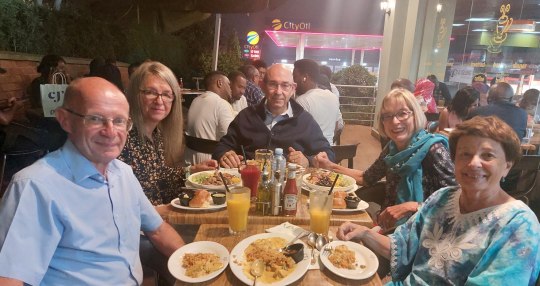
In the evening we went out for a meal together to celebrate Mo’s birthday and a good week of work.
6 notes
·
View notes
Text
“We are here to break male dominance in the field of birding,” says Judith Mirembe, the chair of the Uganda Women Birders Club, as the group reaches the botanical gardens on a day where the weather cannot decide between light rain and sunshine.
Mirembe, in the check shirt, with other female birders, using their phones to find out details about a bird they’ve spotted.
“There are very few female birders in Uganda. The tourism industry in general is yet to fully appreciate women,” she adds.
Two dozen women follow Mirembe in silence, hoping to spot a “lifer” – a bird on their wishlist. “Everyone has a different lifer,” says Linda Nakalema, one of the club’s 80 members. “We see the red-chested cuckoo all the time in Uganda but people from South Africa are very excited when they see it because it only migrates there seasonally. It is their lifer. For others it is the marabou stork that we see scavenging through our rubbish every day. It looks so elegant when it flies.”
Tour companies describe Uganda as a paradise for birdwatchers. About 50% of Africa’s bird species, and 11% of the world’s, are found here. Uganda has the highest concentration of birds in Africa. The country’s birders have an ambitious target of bringing in an annual $700m in tourist revenue by 2030. In 2019, tourism in Uganda generated about $1.37bn, about 3.6% of total GDP.
Mirembe believes that female birders are entitled to a share of these earnings. At the International Conference for Women Birders the club hosted in Uganda earlier this month, female enthusiasts from all over the world met to discuss their unique challenges and discuss how, together, they can bring more money to women in the sector.
“Birding is expensive and many Ugandan women are struggling to meet costs such as buying binoculars, telescopes and cameras to record and share the birds they sight with other people,” she says, adding that cultural expectations of women as caregivers mean their spouses may not let them go for week-long birdwatching tours. “This is our reality. Even tourist operators do not take women seriously and we know that we must work twice as hard as men to get the same respect.”
Members of Uganda’s Women Birders Club, which started in 2013, meet in Entebbe every Sunday. It is a training ground and a support network. Many of the women already have careers in tourism and wildlife. Others join to make new friends and learn.
After the satisfaction of spending hours looking for birds and the joy that reverberates through the group when someone sights, accurately names and describes a bird, the women sit down for lunch in a restaurant. Over smoked beef and matooke (mashed green bananas), they speak of a time when birding could be a hazardous pursuit for women.
People would see women with binoculars, accuse them of trying to steal land and beat them up. Others could be hostile to the women because they wore trousers – a taboo in some Ugandan cultures. They recall tour operators who would send them to the field with drivers who’d sexually harass them and tourist accommodation where the women would be put in a shared room with men.
Miremebe watches the younger enthusiasts with pride as she tells them how Uganda was the first country in Africa to start a female birders’ club, and how there are now similar associations in Rwanda and Kenya.
“We must not let fear hold us back from opportunity. We need to keep it going against all odds,” is Mirembe’s farewell cry, as the women leave the restaurant and head back into Entebbe alongside the tired beachgoers and weary market-sellers.
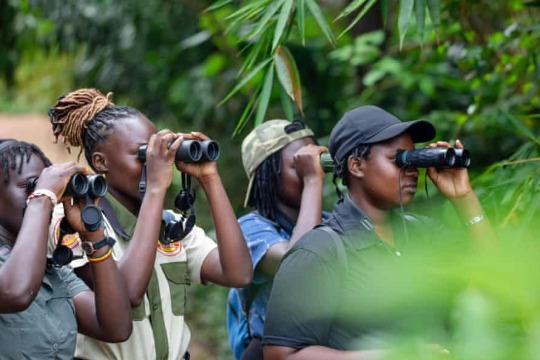
2 notes
·
View notes
Text
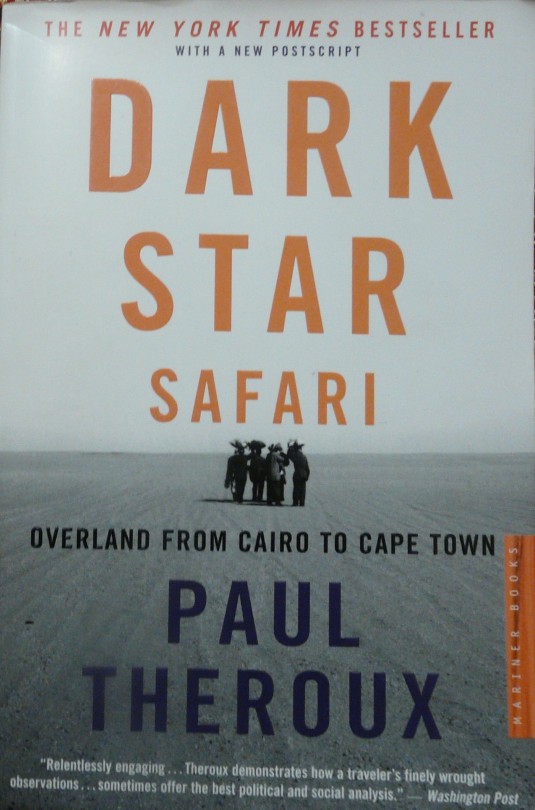
Book Review
Dark Star Safari: Overland from Cairo to Cape Town
by Paul Theroux
Two decades ago, the novelist and travel writer Paul Theroux took an overland trip through Africa, starting in Cairo, Egypt and ending in Cape Town, South Africa. This certainly isn’t the safest or the most comfortable means of experiencing the supposed “dark continent”, but it makes for some interesting experiences and insights. Keeping in mind that Theroux’s observations are just one point of view among many, his resulting book Dark Star provides a unique look at a region of the world that holds a permanent place off the beaten path.
While Dark Star is an easy book to read, breaking it down into its individual elements is a good way to approach its merits and examine its flaws. The first element of importance is Theroux’s sense of place. Wherever he goes, the author describes what he sees and the vibe he gets from his surroundings. Starting on the tourist trail in Egypt, he heads south through Sudan, Ethiopia, Kenya, Tanzania, Uganda, Malawi, Zimbabwe, Mozambique, Zambia, and South Africa. You quickly get a sense of what he appreciates and what he doesn’t. He doesn’t like sites that are swarmed with tourists, nor does he like cities with their concentrations of crime and poverty. He also doesn’t like the “death traps” as he calls public transportation which are usually over-croded minivans driven at dangerous speeds on poorly maintained roads, pockmarked with hippopotamus-sized potholes. If you’ve ever traveled in a Third World country, you will know exaclt what he is talking about.
The places that Theroux does like are usually rural, especially farm lands or jungle villages. These are the places where he sees Africans at their best, meaning Africans being Africans in the absence of corrupt and filthy cities built up on the foundations of European colonialism. Some of the book’s best passages involve descriptions of the pyramids in Sudan which are rarely seen by tourists, a boat trip across Lake Victoria, another boat trip from Malawi across the Zambezi over the border into Zimbabwe, and the pristine countrysides of Zimbabwe and South Africa. All places, whether Theroux likes them or not, are described with language that is clear, simple, and direct, making it easy to visualize what he sees.
Another element that is done to near perfection is writings about the people. Theroux talks with tour guides, people on the streets and in the villages, farmers, nuns, educators, government officials, Indian businessmen, prostitutes, authors, intellectuals, and ordinary people. Just like with the places he goes, he describes these people vividly with precision so that you feel like you quickly get to know them. But not everyone is to his liking. He gets into small argument with a fanatical Rastafarian in Ethiopia, a little ornery with physically fit young men who refuse to work, government officials who demand bribes to do their jobs, and he really gives a hard time to a young American missionary woman about the psychological damage that her evangelical ministry is doing to the local people. There is also plenty of anger directed at clueless tourists as well as NGO and charity workers who he sees as being the Westerners who do the most damage to Africa.
The third element of importance is the author, Paul Theroux himself, and his thoughts and commentaries on everything he sees. Before getting into this subject, it should be mentioned that Theroux had a purpose to his journey. In the 1960s he worked as a Peace Corps volunteer, teaching in Malawi. After getting involved with a Leftist political group, he got fired then accepted a teaching position at a college in Uganda. He wanted to return and see what results, if any, his contributions to Africa grew into. What he found was a major disappointment. The charming campuses and villages where he had lived were in ruins and instead of a thriving civilization, he saw emaciated beggars, starving children, an ignorant populace, and chronically corrupt politicians. Shops that were formerly owned by Indian immigrants were abandoned and burnt to the ground, the result of a campaign of ethnic cleansing. African people wanted to buy from shops owned by Africans, but Africans never took control over the businesses after the Indians were killed or chased away. They resorted to begging, theft, petty crime, prostitution, and laziness instead of making an effort to build better villages for themselves. Due to the hopelessness of African society, the most educated citizens fled to America or Europe instead of staying in their home countries where they were most needed.
Throughout his travels in Tanzania, Uganda, and Malawi, Theroux gets increasingly bitter and cynical. He wanted to see Africans thriving and they weren’t. He directs all his wrath towards the Western charities and NGOs who he says are making the local people dependent on aid rather than learning how to run their societies for themselves. Even worse, these organizations work by bribing corrupt politicians to allow them to do work there, keeping greedy and psychotic leaders in positions of power they don’t deserve. Theroux points out that rural people who have given up on the hopeless market economy and returned to subsistence farming are the happiest and healthiest Africans he encounters. Heecomes close to advocating for a type of post-capitalist agrarian anarchism.
Some readers have criticized Theroux for his pessimistic views on contemporary Africa, but he does cite studies that support what he says. He also encounters a lot of Africans in several different countries that agree with him. To make sense of his negativity, you also have to remember that traveling overland through Africa is not exactly stress free. Anybody who has been on an extended backpacking trip anywhere in the world will tell you that traveler’s fatigue is a real thing. Theroux took a longer than average trip through one of the most underdeveloped regions in the world, got shot at by Somali bandits, stuck in the middle of nowhere when his transportation broke down, and got sick with food poisoning, magnifying his traveler’s fatigue to a outsize extent. These circumstances would make you grouchy too. But even in the darkest times, Theroux never loses his appreciation for Africa, the wildlife, the landscapes, and the people who are trying to make the best of their situations. Besides, by the time he crosses the river from Malawi into Zimbabwe, his mood really lightens up.
Dark Star is an engaging travelogue that should be read both critically and with an open mind. All the while, remember that this is Paul Theroux’s singular point of view. That doesn’t make it wrong; that just means that there are other points of view to take into account that may go against what he says even if they don’t necessarily invalidate his opinions. He saw what he saw and he expresses it well. This is raw and honest travel writing and if you haven’t been tough enough to make the same kind of journey, you’re not in a good place to be judgmental of the conclusions he draws.
5 notes
·
View notes
Text
Gorilla Trekking: A Wildlife Adventure Like No Other

Gorilla trekking is an exciting and awe-inspiring wildlife adventure that allows you to get up close and personal with some of the world's most magnificent creatures. The experience typically involves hiking through lush rainforests, tracking endangered mountain gorillas in their natural habitat, and spending time observing and interacting with them in their family groups.
Gorilla trekking is an unforgettable experience that provides a unique opportunity to witness these gentle giants in the wild, where they live, eat, and play. As you venture into the gorilla's habitat, you'll be surrounded by breathtaking scenery, dense vegetation, and diverse wildlife. The trek itself can be a challenging and exhilarating experience, as you navigate steep terrain and unpredictable weather conditions.
Gorilla trekking is available in several locations across Africa, with the most popular destinations being Uganda, Rwanda, and the Democratic Republic of Congo. These countries are home to several national parks, such as Bwindi Impenetrable Forest, Virunga National Park, and Volcanoes National Park, where visitors can engage in guided tours to observe these majestic creatures.
In addition to providing a thrilling adventure, gorilla trekking also plays a crucial role in conservation efforts. By supporting ecotourism, visitors contribute to the preservation of gorilla habitats and the protection of these magnificent creatures. Gorilla trekking is a unique and meaningful way to connect with nature, learn about conservation efforts, and create lasting memories.
3 notes
·
View notes
Audio
Monkssnap offers single or group trips to Uganda, with Monkssnap as tour guides who give you the maximum of experiences with Ugandan culture, beautiful nature, music, dance, food, everyday life, wildlife, bird life, and much more.
0 notes
Text
Why Choose Valiant Safaris' Small Group Tours?

Personalized Experience
Expert Guides
Flexible Itineraries
Better Wildlife Viewing
Stronger Connections
For solo travelers or those seeking the camaraderie of like-minded adventurers, Valiant Safaris offers exciting small group Uganda safaris with set departures. These expertly designed tours combine Uganda's must-see highlights, including thrilling gorilla treks, diverse wildlife encounters, and breathtaking scenery, all while traveling with a group of no more than 6-8 people. Discover the convenience and affordability of our set departure itineraries, and create unforgettable memories in the company of fellow explorers. Visit: https://www.valiantsafaris.com/small-group-tours/
#ValiantSafaris#SmallGroupTours#AfricanSafaris#WildlifeAdventures#SafariExperience#TravelAfrica#ExploreUganda#BirdingSafaris#NatureTours#EcoFriendlyTravel
0 notes
Text
What to Look for in your Uganda Holidays Packages?
Uganda offers some of the world’s best wildlife and nature attractions; Mountain Gorillas, Chimpanzees, Tree-Climbing lions, and over a thousand bird species. This beautiful country presents one of the diverse geographical terrains in the world with features like savannah, rain forests, Rwenzori Mountains of the moon among others. Read on to get some tips if you are planning to book an excellent Uganda holiday holiday.
The first choice is when to go or what season to choose to visit. Uganda has mild temperatures throughout the year with two dry seasons being December-February and June-August which is most suitable for wildlife spotting. This is the time of the year animals come to ration a few water sources and this boosts your chances of seeing them up close. The rainy seasons should also not be ruled out since the rains are not always a downer and hence can be a good time to visit .
Next, determine your interests. This helps to choose the right Uganda holidays packages focusing on specific animals and environments you would like to watch.

Uganda Holidays Packages
You will also reach a decision on whether to take a scheduled group tour or to go for private Uganda safari holidays. Undertaking the services of a recognised tour operator relieves one of all the complexities of travel and usually entails the services of a professional guide. Private safaris, on the other hand, enable you to change every activity, albeit with more planning measures. Both have fantastic advantages.
When planning for a trip, it is wise to take time and research on the various hotel accommodations, means of transport, park charges and fees, and what to pack among other factors as a way of eliminating such surprises. It is also important to consult with those who have some prior experience with Uganda for they too will be of great help.
An Uganda safari holiday guarantees you stunning views, unique wildlife experience and culture extravagance at every twist. So, proper planning will assist in creating the envisaged ideal experience. Let the discoveries begin!
0 notes
Text
How Much Is a 2-Week Trip to Africa from the USA?

Africa, a continent of stunning diversity, offers an unparalleled travel experience that captivates the hearts of adventurers, nature enthusiasts, and culture seekers alike. From the vast savannas teeming with wildlife to ancient historical sites and vibrant cultures, Africa presents a myriad of attractions that appeal to tourists from around the globe, including the USA. This comprehensive guide aims to provide a detailed breakdown of the costs associated with a two-week trip to Africa from the USA, with a particular focus on the keyword "Africa Tour Packages." Whether you're planning a luxurious safari adventure or a budget-friendly exploration, understanding the financial aspects is crucial for a well-prepared journey.
Geographical Information
Africa's geographical diversity spans across expansive deserts, lush rainforests, towering mountains, and idyllic coastlines. The continent is divided into several regions, each offering unique travel experiences:
East Africa: Known for its iconic wildlife and safari experiences, countries like Kenya, Tanzania, and Uganda offer lush landscapes and renowned national parks.
Southern Africa: Home to South Africa, Namibia, Botswana, and Zimbabwe, this region boasts rich wildlife, desert landscapes, and the awe-inspiring Victoria Falls.
North Africa: Featuring historical wonders like the Pyramids of Giza in Egypt and the cultural richness of Morocco and Tunisia.
West Africa: Known for its vibrant cultures and historical sites, including Ghana's Cape Coast Castle and Nigeria's bustling cities.
The best times to visit vary depending on the region and the type of experience sought. For instance, the dry season, from June to October, is ideal for wildlife viewing in East and Southern Africa. Conversely, North Africa's cooler months from November to March offer a pleasant climate for exploring historical sites.
Cultural Insights in Africa Tour Package
Africa's cultural tapestry is as diverse as its geography, with thousands of ethnic groups and languages. Each region boasts unique traditions, art, music, and culinary delights. Visitors can immerse themselves in local cultures by participating in traditional ceremonies, sampling regional cuisines, and interacting with locals.
Language: English, French, Arabic, and Portuguese are widely spoken, along with numerous indigenous languages.
Cuisine: African cuisine is a blend of flavors, from spicy Moroccan tagines to South African braais (barbecues). Food enthusiasts will find a wide range of tastes to explore.
Etiquette: Respect for local customs and traditions is important. For example, dress modestly in conservative areas and seek permission before taking photographs of people.
Must-Visit Attractions
Africa's allure lies in its diverse attractions. For wildlife enthusiasts, the continent offers some of the best safari experiences:
Serengeti National Park, Tanzania: Famous for the Great Migration, where millions of wildebeests and zebras traverse the plains.
Maasai Mara, Kenya: Known for its abundant wildlife, including the Big Five (lion, elephant, buffalo, leopard, and rhino).
Kruger National Park, South Africa: A premier safari destination offering excellent game viewing.
History buffs can explore ancient sites like the Pyramids of Giza and the Great Zimbabwe Ruins, while nature lovers will be mesmerized by the Victoria Falls and the Sahara Desert.
Activities and Experiences
Africa offers a wide range of activities to suit every traveler's taste:
Wildlife Safaris: Experience game drives, walking safaris, and boat safaris in various national parks and reserves.
Cultural Tours: Visit local villages, engage with indigenous communities, and learn about traditional lifestyles.
Adventure Activities: From hiking Mount Kilimanjaro to diving in the coral reefs of the Indian Ocean, the continent caters to adventure seekers.
Relaxation: Enjoy the beautiful beaches of Zanzibar, the Seychelles, or the Garden Route in South Africa.
Travel Tips
Planning a trip to Africa involves careful consideration of logistics:
Flights: Major airlines offer flights from the USA to various African destinations. It's advisable to book flights well in advance for better deals.
Accommodation: Options range from luxury lodges and resorts to budget-friendly guesthouses and campsites.
Transportation: Depending on the destination, travelers can choose from domestic flights, car rentals, or guided tours. Public transport options vary in reliability and safety.
Safety and Health Precautions
Safety and health are paramount when traveling to Africa:
Vaccinations: Some countries require vaccinations, such as Yellow Fever. It's also advisable to take antimalarial medication if traveling to malaria-endemic areas.
Travel Insurance: Comprehensive travel insurance is essential to cover medical emergencies, trip cancellations, and lost belongings.
Safety Tips: Stay informed about local safety conditions, avoid displaying valuables, and be cautious when interacting with wildlife.
Budget Planning
Understanding the cost components of a trip to Africa is crucial for effective budgeting:
Flights: Costs can vary widely based on the season and the city of departure. Expect to spend anywhere from $800 to $1,500 for a round-trip ticket.
Accommodation: Prices range from $50 per night for budget accommodations to over $500 for luxury lodges.
Food: Dining expenses can vary, with street food and local eateries being more affordable than upscale restaurants.
Activities: Safaris and excursions can be a significant part of the budget. Costs depend on the type and duration of activities.
Local Cuisine
African cuisine is a delightful journey through diverse flavors:
South African Braai: A traditional barbecue featuring a variety of meats.
Kenyan Nyama Choma: Grilled meat, often served with ugali (maize porridge).
Ethiopian Cuisine: Known for dishes like injera (sourdough flatbread) and doro wat (spicy chicken stew).
Conclusion
Africa is a continent of contrasts and unparalleled beauty, offering something for every traveler. From breathtaking landscapes and rich cultural experiences to thrilling wildlife encounters, a trip to Africa promises unforgettable memories. By understanding the costs and planning carefully, travelers can embark on a journey that fits their budget while experiencing the best the continent has to offer.
For more information and to explore various Africa Tour Packages, visit Wild Voyager.
1 note
·
View note
Text
Exploring Bwindi: Cultural Experiences That Have Made It Famous
Bwindi Impenetrable National Park in Uganda is celebrated not only for its rich biodiversity but also for its vibrant cultural heritage. Nestled amidst ancient rainforests and mist-covered mountains, Bwindi offers travelers a unique opportunity to immerse themselves in the traditions and lifestyles of indigenous communities. Here’s a look at the cultural experiences that have contributed to Bwindi's fame as a must-visit destination:
1. Batwa Cultural Encounters
One of the most distinctive cultural experiences in Bwindi is interacting with the Batwa pygmies, an indigenous group that has inhabited the region for centuries. The Batwa were traditionally hunter-gatherers who lived in harmony with the forest, relying on its resources for food, medicine, and shelter. Today, cultural tours led by Batwa guides offer insights into their traditional way of life, including demonstrations of hunting techniques, gathering practices, and knowledge of medicinal plants.

2. Traditional Music and Dance
Music and dance are integral parts of Batwa culture, serving as expressions of identity, spirituality, and community. Visitors to Bwindi have the opportunity to witness vibrant performances of traditional Batwa songs and dances, accompanied by rhythmic drumming and storytelling that recount the group's history and connection to the forest.

3. Craftsmanship and Artisanal Skills
Batwa artisans showcase their craftsmanship through traditional handicrafts such as basket weaving, pottery, and beadwork. Cultural tours often include demonstrations where visitors can observe the intricate techniques used to create these unique and culturally significant items. Purchasing Batwa crafts directly supports community livelihoods and preserves traditional skills passed down through generations.

4. Medicinal Plant Knowledge
The Batwa have deep-rooted knowledge of the medicinal properties of plants found in Bwindi's rainforests. Guided walks with Batwa guides highlight the importance of medicinal plants in traditional healing practices, revealing how specific herbs and remedies are used to treat ailments and promote well-being within the community.

5. Cultural Significance of the Forest
For the Batwa, Bwindi's forests are not just a habitat but a sacred and integral part of their cultural identity. Stories and legends passed down through generations underscore the spiritual connection between the Batwa and the natural environment, emphasizing the importance of conservation and sustainable use of forest resources.
Conservation and Community Impact
Cultural tourism initiatives in Bwindi play a vital role in preserving Batwa culture, promoting cultural exchange, and supporting community development. Revenue generated from cultural tours contributes to education, healthcare, and infrastructure projects that benefit local communities and ensure their participation in ecotourism activities.
Planning Your Cultural Experience
To fully appreciate Bwindi's cultural heritage, consider incorporating a cultural tour into your itinerary alongside activities like gorilla trekking and nature walks. Engage with local communities respectfully, support sustainable tourism practices, and cherish the opportunity to learn from the Batwa about their enduring connection to Bwindi's ancient forests.
Conclusion
Bwindi Impenetrable National Park stands as a testament to the intersection of cultural diversity and natural beauty. The cultural experiences offered by the Batwa pygmies enrich the visitor experience, fostering a deeper understanding of Bwindi's significance as both a biodiversity hotspot and a cultural treasure trove. Whether you're captivated by traditional music, fascinated by artisanal craftsmanship, or inspired by stories of resilience and adaptation, Bwindi promises a journey that celebrates the enduring bond between peopl
#travel blog#safari#africa#travel destinations#artists on tumblr#across the spiderverse#barbie#donald trump#easter#asexual
0 notes
Text
Few Crucial Guidelines if you are Up for The Best gorilla safari in Uganda
With less than 1004 mountain gorillas remaining on the planet today, Uganda is home to half of these gigantic creatures, making it one of just three nations where mountain gorilla trekking is possible. The Best gorilla safari in Uganda takes place in two national parks. 18 habituated gorilla families have already been set up for tourist purposes, with 17 monitored in Bwindi Impenetrable National Park and only one in Mgahinga National Park.

Bwindi Impenetrable National Park
This spectacular lush expanse over the rocky hills of the Albertine Rift Valley is home to about half of the world’s mountain gorilla population. This ancient rainforest is one of Africa's few woods that thrived during the previous Ice Age. 90 animal species, including 11 primates, the black-and-white colobus with a beautiful flowing white tail are found in the national park. Bwindi National Park has four major hiking districts, including the Ruhija sector in the east, home to gorilla families such as Mukiza, Oruzogo, Bitukura, and Kyaguliro.
The Buhoma region in the north has gorilla groups like Habinyanja, Katwe, Mubare, and Rushegura; the Nkuringo area in the south has groups like Christmas, Nkuringo, and Bushaho; and the Rushaga region has habituated families like Kutu, Bikingi, Mishaya, Busingye, Kahungye, Rwigi, Bweza, Nshongi, and Mucunguzi.
Mgahinga Gorilla National Park
Mgahinga Gorilla National Park is located in the far southwestern part of the country, around 8-10 hours' drive from Entebbe or Kampala. The park includes the northern slopes of the three northernmost Virunga volcanoes: Mt. Muhavura (4,127 m), Mt. Gahinga (3,474 m), and Mt. Sabinyo (3,645 m).
The Park is located around 10 kilometers south of Kisoro and is bordered to the south by Rwanda and to the west by the Democratic Republic of Congo. Tourists can take a three-day gorilla tour in Mgahinga at any time of year. The Nyakagezi gorilla group is the only habituated gorilla family in Mgahinga Gorilla National Park that tourists may trek with.

Best time to go gorilla trekking in Uganda.
Any time of year, Gorilla trekking in Uganda may be done at. Uganda has two distinct seasons: the dry and wet season. Visitors planning to hike mountain gorillas should keep in mind that gorilla tracking is a time-consuming exercise that might take all day. The guide takes you around the gorilla's habitat, describing aspects of their ecology and behavior along the way.
The dry season is ideal for gorilla trekking in Uganda since the ground is dry. It begins in June, July, August, September, December, and January/February. During the dry season, the environment is maintained drier, making it simpler for trekkers to hunt for mountain gorillas through dense foliage and steep slopes, as opposed to the wet/rainy season, when the ground becomes muddy and treacherous due to heavy rainfall.
The rainy season, also known as the low season, begins in March, April, May, and October/November. The advantage of hiking mountain gorillas during the wet or rainy season is that there is plenty of fodder for these giant apes to rely on, and tourists may spend fewer hours since they do not have to go long distances to find food during the day.
Get your gorilla permit early enough.
Given the high demand for gorilla permits, you should get your gorilla trekking permit at least 6 months before embarking on your actual trip, especially if you intend to do a gorilla safari during the June to September peak months. You may book one through a trustworthy ground tour operator in Uganda or the Uganda Wildlife Authority's reservation office. If you want to go on a gorilla habituation trip, you must first obtain a permit, which will grant you a whole day and four hours of amazing encounters with mountain gorillas.
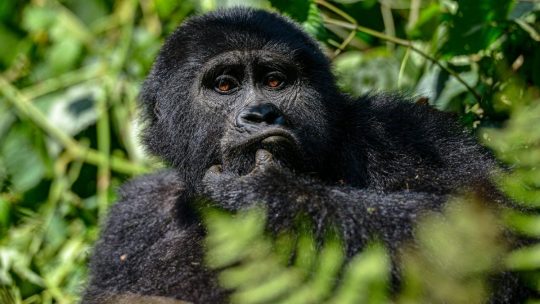
Conclusion
With the advice above, we hope you have a fantastic vacation to view gorillas in Uganda, the Pearl of Africa, a nation full of engaging adventures. It is critical to remember these guidelines while organizing your next vacation so that you may have an African experience that cannot be found anywhere else on the globe! To add variety to your Best gorilla safari in Uganda, consider traditional game-viewing safaris in savanna national parks, chimpanzee tracking, mountaineering, bird watching, sport fishing, or simply admiring Uganda's stunning scenery.
#gorilla trekking in uganda#uganda safari tour packages#7-day birding murchison falls in uganda#affordable uganda safaris#best uganda safari tours#books & libraries#best gorilla safari in uganda#10-day uganda best safari tour#aesthetic#crystals
0 notes
Text
Uganda Wildlife Safari: An Adventure of a Lifetime

A Uganda wildlife safari is an adventure of a lifetime, offering the chance to experience the diverse and abundant wildlife that makes Uganda such a unique and exciting destination. Here are some of the highlights of a Uganda wildlife safari:
Gorilla Trekking: Uganda is home to half of the world's remaining mountain gorillas, and gorilla trekking is a thrilling experience that takes you deep into the heart of the forest to observe these gentle giants in their natural habitat.
Big Game Viewing: Uganda is home to several national parks that offer excellent game viewing opportunities. Embark on a game drive in Queen Elizabeth National Park, Murchison Falls National Park, or Kidepo Valley National Park, and spot elephants, lions, leopards, giraffes, buffaloes, and more.
Chimpanzee Tracking: Uganda is also home to several chimpanzee populations, and chimpanzee tracking is a unique adventure that takes you through the forests of Kibale National Park, Budongo Forest Reserve, or Kyambura Gorge.
Birdwatching: Uganda is a birdwatcher's paradise, with over 1,000 bird species recorded in the country. Visit Mabamba Swamp, Bwindi Impenetrable National Park, or Kibale Forest National Park to spot rare and endemic bird species.
Cultural Tours: Uganda is a culturally diverse country, with over 50 different ethnic groups. Visit traditional villages, meet the local people, and learn about their customs and traditions on a cultural safari tour.
River Safaris: Take a boat safari along the Nile River and explore the stunning Murchison Falls, or cruise through the Kazinga Channel in Queen Elizabeth National Park to observe hippos, crocodiles, and a variety of bird species.
Hiking and Nature Walks: Uganda is also known for its scenic beauty, and hiking and nature walks are great ways to experience the country's natural wonders. Explore the lush forests of Bwindi Impenetrable National Park or Mgahinga Gorilla National Park, or hike to the top of Sipi Falls for breathtaking views of the surrounding landscape.
A Uganda wildlife safari is an adventure of a lifetime, offering a unique and unforgettable experience in one of the most diverse and beautiful countries in Africa.
2 notes
·
View notes